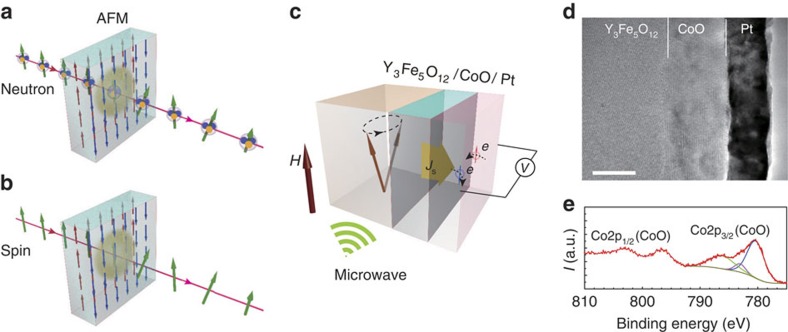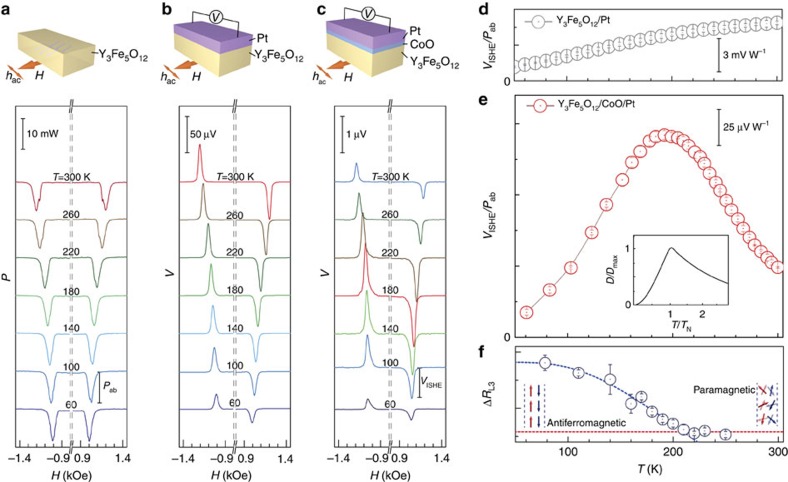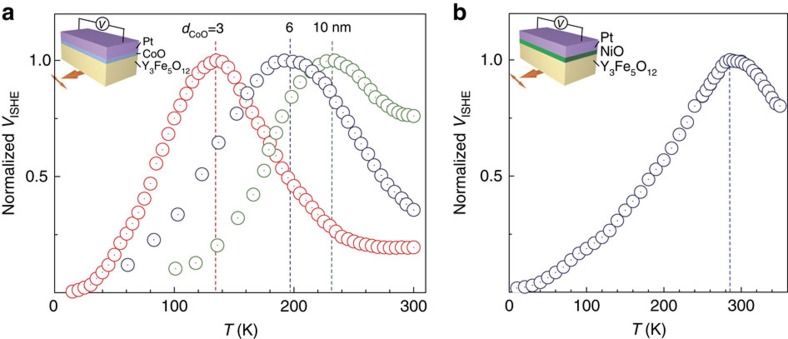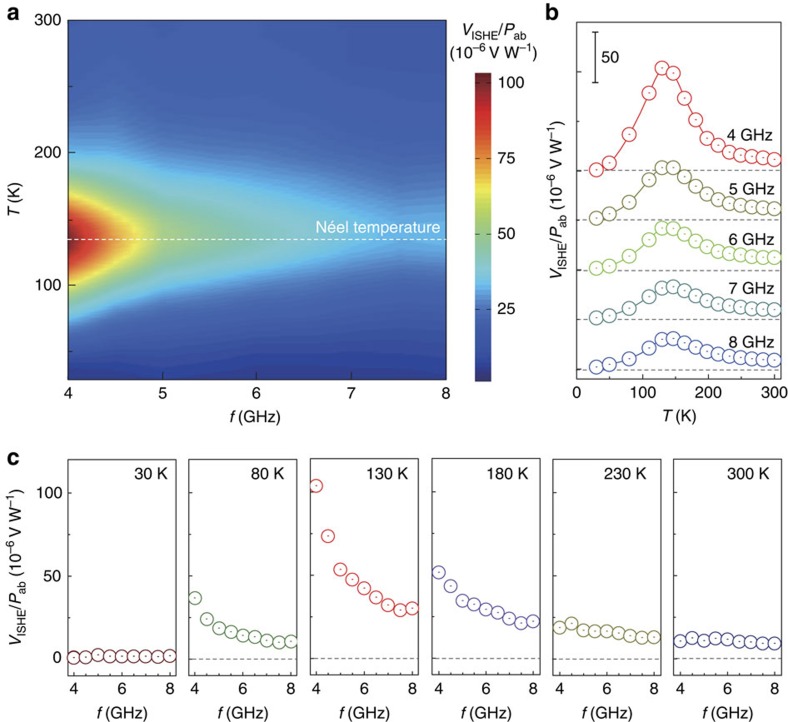Abstract
Spin fluctuation and transition have always been one of the central topics of magnetism and condensed matter science. Experimentally, the spin fluctuation is found transcribed onto scattering intensity in the neutron-scattering process, which is represented by dynamical magnetic susceptibility and maximized at phase transitions. Importantly, a neutron carries spin without electric charge, and therefore it can bring spin into a sample without being disturbed by electric energy. However, large facilities such as a nuclear reactor are necessary. Here we show that spin pumping, frequently used in nanoscale spintronic devices, provides a desktop microprobe for spin transition; spin current is a flux of spin without an electric charge and its transport reflects spin excitation. We demonstrate detection of antiferromagnetic transition in ultra-thin CoO films via frequency-dependent spin-current transmission measurements, which provides a versatile probe for phase transition in an electric manner in minute devices.
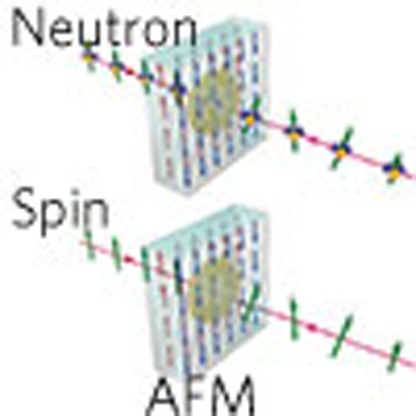 Whilst neutron scattering is a powerful tool for studying spin fluctuations in materials, its availability is limited to large-scale user facilities. Here, the authors demonstrate how the pumping of pure spin currents can be used as a desktop probe to detect an antiferromagnetic transition.
Whilst neutron scattering is a powerful tool for studying spin fluctuations in materials, its availability is limited to large-scale user facilities. Here, the authors demonstrate how the pumping of pure spin currents can be used as a desktop probe to detect an antiferromagnetic transition.
A spin current refers to a flow of spin angular momentum of electrons in condensed matter1. There are types of spin currents, including a spin current carried by conduction electrons and one carried by spin waves1. The former type of spin current, conduction-electron spin current, can be detected by using the inverse spin Hall effect (ISHE)2,3,4,5,6,7, the conversion of a spin current into electric voltage via the spin–orbit interaction in a conductor, typically in Pt. Although conduction-electron spin current can reside only in metals and semiconductors, the latter type of spin current, called spin-wave spin current, can exist even in insulators.4,8 In fact, spin-wave spin currents have been studied in magnetic insulators and, very recently, in antiferromagnetic alloys and insulators9,10,11,12,13,14,15.
For spin-current generation, one of the most versatile and powerful methods is spin pumping, an induction of spin current from magnetization precession in a magnetic metal into an attached metal via the exchange interaction at the interface5. Spin pumping was found to drive spin current also from magnetic insulators, such as Y3Fe5O12 (refs 4, 6, 16, 17, 18, 19, 20, 21, 22).
Various powerful theories have been constructed to describe the spin-pumping phenomenon23,24,25. They commonly predict that the efficiency of spin pumping is sensitive to dynamical magnetic susceptibility at the interface between a magnet and a metal in a spin-pumping system. Therefore, spin pumping is sensitive to interface magnetic susceptibility, while standard magnetometry probes bulk properties which often hides interface signals. This raises an interesting hypothesis: when a very thin sample film is inserted at the interface of a spin-pumping system, spin pumping may reflect the dynamical susceptibility, which is directly related to spin fluctuation according to the fluctuation-dissipation theory, of the inserted thin sample film. Here we show that this is the case by using an antiferromagnetic transition in an ultra-thin film of CoO, and that spin pumping becomes an in situ microprobe for magnetic phase transition.
Results
Sample description
Figure 1c is a schematic illustration of the sample system used in the present study; we inserted an antiferromagnetic CoO thin film at the interface between Y3Fe5O12 and Pt layers in a typical spin-pumping system Y3Fe5O12/Pt to form Y3Fe5O12/CoO/Pt. At low temperatures, CoO exhibits antiferromagnetic order26. Here, Y3Fe5O12 is a typical spin-pumping material, by which spin current is emitted when magnetization precession is excited4,6. Pt is used as a spin-current detector based on ISHE, in which a spin current is converted into an electric voltage in Pt perpendicular to the spin-current spin polarization direction2,3,4,6. When magnetization precession in Y3Fe5O12 is excited by a microwave application, spin pumping is driven and then a spin current is injected from the Y3Fe5O12 layer into the Pt layer across the thin CoO layer23,24,25.
Figure 1. Concept and sample set-up.
(a) Inelastic scattering of polarized neutrons through an antiferromagnetic system. (b) Spin-current transmission through an antiferromagnetic system. (c) Experimental set-up of the spin-pumping measurement for the Y3Fe5O12/CoO/Pt trilayer device. Js denotes spin current injected from the Y3Fe5O12 layer into the Pt layer through the CoO layer by spin pumping, which is detected as a voltage signal via the inverse spin Hall effect in the Pt layer. (d) A cross-sectional TEM image of a Y3Fe5O12/CoO/Pt trilayer device. Scale bar, 10 nm. (e). A Co 2p XPS spectrum and Gaussian fitting analysis for the CoO layer in the Y3Fe5O12/CoO/Pt trilayer device. TEM, transmission electron microscopy; XPS, X-ray photoemission spectroscopy.
Spin-pumping signal of Y3Fe5O12/CoO/Pt system
Figure 2a shows the magnetic field dependence of microwave absorption spectra of Y3Fe5O12 at various temperatures measured when a 5 GHz microwave is applied. At T=300 K, absorption peaks appear around HFMR=±1.2 KOe, which correspond to ferromagnetic resonance (FMR) in the Y3Fe5O12. With decreasing temperature, HFMR is observed to slightly decrease, which is due to the temperature dependence of magnetization in the Y3Fe5O12. The microwave absorption power Pab at HFMR is almost constant with changing T.
Figure 2. Spin-pumping detection of antiferromagnetic transition.
(a) Magnetic field (H) dependence of microwave absorption power (P) for a Y3Fe5O12 film (3 μm in thickness) at various temperatures. Pab denotes absorption power at FMR field. (b) Magnetic field (H) dependence of electric voltage (V) generated in the Y3Fe5O12 (3 μm)/Pt (10 nm) bilayer film at various temperatures. (c) Magnetic field (H) dependence of electric voltage (V) generated in the Y3Fe5O12 (3 μm)/CoO (6 nm)/Pt (10 nm) trilayer film at various temperatures. VISHE denotes the voltage signal at the FMR field. (d) Temperature dependence of VISHE for the Y3Fe5O12 (6 μm)/Pt (10 nm) bilayer film. (e) Temperature dependence of VISHE for the Y3Fe5O12 (3 μm)/CoO (6 nm)/Pt (10 nm) trilayer film. The inset shows the theoretical prediction of the spin conductance versus temperature in an antiferromagnetic system with S=1/2 (ref. 38). Coefficient D denotes the spin conductance at a given frequency scaled by its maximum value Dmax. (f) Temperature dependence of the XMLD signal ΔRL3 for the Y3Fe5O12 (3 μm)/CoO (6 nm)/Pt (1 nm) trilayer film (details are shown in Supplementary Note 1). The error bars in d–f represent the s.d. of multiple measurements at the same condition. XMLD, X-ray magnetic linear dichroism.
In Fig. 2b, we show the voltage V generated in the Pt layer in a simple Y3Fe5O12/Pt spin-pumping system without a CoO layer measured by applying a 5 GHz microwave. At the FMR field HFMR, a clear voltage peak appears at all temperatures. The sign of the peak voltage VISHE is reversed by reversing the polarity of the applied magnetic field, showing that the voltage peak is due to ISHE induced by spin current pumped from the Y3Fe5O12 layer2,3,4,23,24,25.
Figure 2d shows the temperature dependence of the peak voltage VISHE for the Y3Fe5O12/Pt film without a CoO layer. VISHE decreases monotonically with decreasing the temperature. This monotonic decrease is attributed to the decrease in the resistivity of Pt and the increase in the magnetization damping in Y3Fe5O12.
On the contrary by inserting a CoO layer in the simple spin-pumping system, a clear unconventional peak structure appears in the temperature dependence of the ISHE signal (Fig. 2c). Figure 2e shows the temperature dependence of the voltage peak intensity VISHE for the Y3Fe5O12/CoO/Pt trilayer film. The VISHE for the Y3Fe5O12/CoO/Pt trilayer film exhibits a clear peak at T=200 K, which is quite different from that for the Y3Fe5O12/Pt bilayer film (Fig. 2d). The VISHE peak temperature is comparable to the Néel temperature of the CoO layer determined by an X-ray magnetic linear dichroism measurement using a synchrotron facility as shown in Fig. 2f (for detailed data, please see Supplementary Note 1 and Supplementary Figs 1 and 2). Furthermore, the temperature dependence of VISHE is similar to that of the magnetic susceptibility in a bulk CoO, in which the susceptibility is maximized around the Néel temperature TN (refs 27, 28).
Spin pumping with different CoO layer thickness
Figure 3a shows the temperature dependence of VISHE measured for various thicknesses of the CoO layer in Y3Fe5O12/CoO/Pt trilayer films. In CoO films, the Néel temperature is known to decrease with decreasing the thickness of the film due to the finite size effect29,30. The observed CoO-thickness dependence of the peak temperature is consistent with this feature: the peak temperature decreases with decreasing the CoO layer thickness. All the results show that the VISHE peak position indicates the Néel temperature of the CoO layer, and that the VISHE enhancement around the antiferromagnetic transition can be related to the CoO-film susceptibility enhancement, which is a good measure for spin fluctuations.
Figure 3. Temperature dependence of spin-pumping signals in different systems.
(a) Temperature dependence of VISHE for Y3Fe5O12/CoO/Pt trilayer films with different CoO-layer thicknesses (dCoO=3, 6 and 10 nm). (b) Temperature dependence of VISHE for a Y3Fe5O12/NiO(1.5 nm)/Pt film. The dash lines in a,b denote the peak positions.
Spin-pumping signal of Y3Fe5O12/NiO/Pt system
To check the universality of the phenomenon, we measured another antiferromagnet: a NiO film (1.5 nm) in a Y3Fe5O12/NiO/Pt system and found a similar peak structure and temperature dependence of VISHE (Fig. 3b). The peak position is consistent with the previous study on the Néel temperature in ultra-thin NiO films31. Furthermore, when a Cu layer is inserted between the Y3Fe5O12 and the CoO (NiO) layers, we observed similar peak structures in the T-dependent ISHE signal (Supplementary Note 2 and Supplementary Fig. 3). This result suggests that the direct exchange coupling between Y3Fe5O12 and an antiferromagnet is not necessary for the VISHE enhancement around Néel temperatures. Although observing such a phase transition in a single ultra-thin film was impossible without using large synchrotron facilities and a special X-ray magnetic linear dichroism spectrometer32,33,34, our present method provides a way to probe it by a table-top experiment.
Discussion
Our present study stimulates further investigations of not only the spin transport near magnetic phase transitions but also microscopic spin-transport properties in antiferromagnetic systems. In antiferromagnetic insulators, incoherent thermal magnons and coherent Néel-order parameter dynamics12 are considered to be responsible for transporting spins. Our experimental results in Fig. 3, however, show that VISHE is strongly suppressed towards lower temperatures in both cases of Y3Fe5O12/CoO/Pt and Y3Fe5O12/NiO/Pt systems; VISHE at 10 K is much less than that at TN. Also, we notice that this feature was confirmed by some recent studies35,36. These results indicate that the spins are transported dominantly by incoherent thermal magnons rather than coherent Néel dynamics. At high temperatures, thermal magnons continuously evolve into thermal spin fluctuations, which would transport spin current above Néel temperature.
Such thermal spin dynamics both below and above TN are well described by a bosonic auxiliary particle method37. Using this method, the spin conductivity in an antiferromagnetic insulator was shown to be maximized near its Neel temperature38, exactly like our VISHE (Fig. 2e inset). Since VISHE measures spin moments transferred across magnetic insulators, its enhancement directly reflects that of the spin conductivity. The spin conductivity and the magnetic susceptibility are in principle different quantities. However, their temperature dependences are rather similar because both are dominated by spin excitations with zero momentum transfer. Therefore, VISHE in our experimental set-up is a good measure for the spin dynamics and transition.
Moreover, another significant remark on our result which requires further theoretical understanding is the frequency dependence of the spin-pumping behaviour. Figure 4a shows the microwave frequency f as well as the temperature T dependence of VISHE/Pab for the Y3Fe5O12/CoO/Pt trilayer film, where VISHE is normalized by the FMR microwave absorption Pab. For all the frequencies, VISHE/Pab shows peaks around the Néel temperature TN∼130 K. As seen in Fig. 4c, VISHE/Pab exhibits different f dependence at different temperatures, namely VISHE/Pab strongly depends on f only near TN∼130 K, but it weakly depends on f at temperatures far from TN. Such a strong frequency dependence implies that the observed phenomena reflect dynamical properties. Similar frequency dependence was also observed in the Y3Fe5O12/NiO/Pt trilayer film, but it was absent in the Y3Fe5O12/Pt bilayer film without antiferromagnetic layers (Supplementary Note 3 and Supplementary Fig. 4), showing that the observed prominent frequency dependence is characteristic to the antiferromagnetic layers near TN. This type of strong frequency dependence cannot be explained by the coherent Néel dynamics or simple thermal magnons alone. First, coherent precession of Y3Fe5O12 can pump antiferromagnetic magnons at the Y3Fe5O12/antiferromagnetic interface, in analogy to the conventional spin pumping at the ferromagnet/metal interfaces12. Second, the FMR dynamics inside of Y3Fe5O12 itself should pump thermal magnons, which can subsequently diffuse across the structure, inducing the ISHE signal. This latter process relies on the breaking of the SU(2) symmetry of magnetic dynamics39, which would be progressively enhanced with the increased ellipticity of the coherent dynamics in Y3Fe5O12. Increased ellipticity of the Kittel mode in Y3Fe5O12 at lower frequencies can thus be responsible for the enhancement of the conversion of the coherent precession into thermal magnons, leading to the observed increase in the signal. Alternatively, the finite lifetime of thermal magnons could be a source of the observed frequency dependence as in the case of the frequency-dependent spin conductance38. In principle, the magnon lifetime depends on temperature and other intrinsic and extrinsic effects. A detailed theoretical analysis of the interplay of the coherent and incoherent magnetic dynamics in our heterostructure is, however, beyond the scope of this work. Constructing a comprehensive theory for spin-current transport in magnetic heterostructures is an important outstanding task for the development of novel spintronics based on quantum magnets.
Figure 4. Frequency dependence of spin-pumping signals in Y3Fe5O12/CoO/Pt.
(a) A pseudo-colour plot of VISHE/Pab as a function of the temperature T and the microwave frequency f for the Y3Fe5O12 (3 μm)/CoO (3 nm)/Pt (10 nm) trilayer film. (b) Temperature (T) dependence of VISHE/Pab at various exciting microwave frequencies. (c) Exciting microwave frequency (f) dependence of VISHE/Pab at various temperatures. We did not show the data for frequencies lower than 4 GHz because the magnetization precession can be modulated due to the three-magnon interaction when f<4 GHz (ref. 40).
Methods
Preparation of Y3Fe5O12/CoO/Pt samples
A 3 μm-thick single-crystalline Y3Fe5O12 film was grown on a (111) Gd3Ga5O12 wafer by a liquid phase epitaxy method at 1,203 K in a PbO-B2O3 based flux. All the samples were cut from a same wafer into 1.5 × 3 mm2 in size. CoO films with differencit thicknesses were coated on the Y3Fe5O12 film by an radio frequency magnetron sputtering method. All the CoO films were prepared at 1,073 K to restrain the formation of cobalt oxide with other valence states and to improve the crystallinity. Then, 10-nm-thick Pt films were put on the top of the CoO films with a Hall-bar structure by an radio frequency magnetron sputtering method.
Sample characterization
Crystallographic characterization for samples was carried out by a X-ray diffractometry and transmission electron microscopy. A transmission electron microscopy image shows that the Y3Fe5O12 film is of a single-crystal structure, and CoO and Pt layers are nearly epitaxially grown on the Y3Fe5O12 film (Fig. 1d). An X-ray photoelectron spectroscopy method was used to confirm the chemical valence of the CoO layer (Fig. 1e).
Spin-pump experimental set-up
The spin-pumping measurement was performed in a physical property measurement system (PPMS), Quantum Design, Inc. To excite FMR in the Y3Fe5O12 layer, microwave was applied by using a coplanar waveguide. The voltage signal between the ends of the Pt layer was measured by using a lock-in amplifier. Temperature dependence measurement was carried out from 10 to 300 K, after cooling samples from room temperature to 10 K in a 5,000 Oe magnetic field.
Data availability
All relevant data are available from the corresponding author on request.
Additional information
How to cite this article: Qiu, Z. et al. Spin-current probe for phase transition in an insulator. Nat. Commun. 7:12670 doi: 10.1038/ncomms12670 (2016).
Supplementary Material
Supplementary Figures 1-4, Supplementary Notes 1-3 and Supplementary References
Acknowledgments
This work was supported by JST-ERATO 'Spin Quantum Rectification', JST-PRESTO 'Phase Interfaces for Highly Efficient Energy Utilization', Grant-in-Aid for Scientific Research on Innovative Area, 'Nano Spin Conversion Science' (26103005 and 26103006), Grant-in-Aid for Scientific Research (S) (25220910), Grant-in-Aid for Scientific Research (A) (25247056 and 15H02012), Grant-in-Aid for Challenging Exploratory Research (26600067), Grant-in-Aid for Research Activity Start-up (25889003), and World Premier International Research Center Initiative (WPI), all from MEXT, Japan, the ImPACT program of the Council for Science, Technology and Innovation, Cabinet Office, Japan, and NEC corporation. Financial support from National Science Foundation DMR-1504568, Future Materials Discovery Program through the National Research Foundation of Korea (No. 2015M3D1A1070467), and Science Research Center Program through the National Research Foundation of Korea (No. 2015R1A5A1009962) is gratefully acknowledged (J. L., A. T., Z. Q.). The Advanced Light Source is supported by the US Department of Energy under contract number DE-AC02-05CH11231 (E.A., A.N.). The research by S.O. is supported by the US Department of Energy, Office of Science, Basic Energy Sciences, Materials Sciences and Engineering Division. Y.T is supported by U.S. Department of Energy, Office of Basic Energy Sciences under Award No. DE-SC0012190.
Footnotes
Author contributions Z.Q. and D.H. designed the experiment, fabricated the samples, collected all of the data and analysed the data. E.S. supervised this study. J.L., Z.Q.Q., E.A., A.T.N.D. and A.T. performed the XMLD and XMCD measurements. K.S., S.O. and Y.T. contribute theoretical suggestions. K.U. helped the low-temperature experiment. Z.Q., D.H., E.S., S.O., K.S., K.U. and Y.T. wrote the manuscript. All the authors discussed the results and commented on the manuscript.
References
- Maekawa S. (ed.) Concepts in Spin Electronics Oxford University Press (2006). [Google Scholar]
- Saitoh E., Ueda M., Miyajima H. & Tatara G. Conversion of spin current into charge current at room temperature: inverse spin-Hall effect. Appl. Phys. Lett. 88, 182509 (2006). [Google Scholar]
- Azevedo A., Vilela Leao L. H., Rodriguez-Suarez R. L., Oliveira A. B. & Rezende S. M. DC effect in ferromagnetic resonance: evidence of the spin-pumping effect? J. Appl. Phys. 97, 10C715 (2005). [Google Scholar]
- Kajiwara Y. et al. Transmission of electrical signals by spin-wave interconversion in a magnetic insulator. Nature 464, 262 (2010). [DOI] [PubMed] [Google Scholar]
- Ando K. et al. Inverse spin-Hall effect induced by spin pumping in metallic system. J. Appl. Phys. 109, 103913 (2011). [Google Scholar]
- Qiu Z. et al. Spin mixing conductance at a well-controlled platinum/yttrium iron garnet interface. Appl. Phys. Lett. 103, 092404 (2013). [Google Scholar]
- Jungwirth T., Wunderlich J. & Olejnik K. Spin Hall effect devices. Nat. Mater. 11, 382 (2012). [DOI] [PubMed] [Google Scholar]
- Schneider T. et al. Realization of spin-wave logic gates. Appl. Phys. Lett. 92, 022505 (2008). [Google Scholar]
- Cheng R., Xiao J., Niu Q. & Brataas A. Spin pumping and spin-transfer torques in antiferromagnets. Phys. Rev. Lett. 113, 057601 (2014). [DOI] [PubMed] [Google Scholar]
- Wang H., Du C., Hammel P. & Yang F. Antiferromagnonic spin transport from Y3Fe5O12 into NiO. Phys. Rev. Lett. 113, 097202 (2014). [DOI] [PubMed] [Google Scholar]
- Moriyama T. et al. Anti-damping spin transfer torque through epitaxial nickel oxide. Appl. Phys. Lett. 106, 162406 (2015). [Google Scholar]
- Takei S., Moriyama T., Ono T. & Tserkovnyak Y. Antiferromagnet-mediated spin transfer between a metal and a ferromagnet. Phys. Rev. B 92, 020409(R) (2015). [Google Scholar]
- Wang H., Du C., Hammel P. C. & Yang F. Spin transport in antiferromagnetic insulators mediated by magnetic correlations. Phys. Rev. B 91, 220410(R) (2015). [Google Scholar]
- Zhang W. et al. Spin Hall effects in metallic antiferromagnets. Phys. Rev. Lett. 113, 196602 (2014). [DOI] [PubMed] [Google Scholar]
- Frangou L. et al. Enhanced spin pumping by antiferromagnetic IrMn thin films around the magnetic phase transition. Phys. Rev. Lett. 116, 077203 (2015). [DOI] [PubMed] [Google Scholar]
- Qiu Z. et al. All-oxide system for spin pumping. Appl. Phys. Lett. 100, 022402 (2012). [Google Scholar]
- Hou D. et al. Interface induced inverse spin Hall effect in bismuth/permalloy bilayer. Appl. Phys. Lett. 101, 042403 (2012). [Google Scholar]
- Harii K. et al. Spin pumping in a ferromagnetic/nonmagnetic/spin-sink trilayer film: spin current termination. Key Eng. Mater. 508, 266 (2012). [Google Scholar]
- Qiu Z. et al. Experimental investigation of spin Hall effect in indium tin oxide thin film. Appl. Phys. Lett. 103, 182404 (2013). [Google Scholar]
- Iguchi R. et al. Spin pumping by nonreciprocal spin waves under local excitation. Appl. Phys. Lett. 102, 3 (2013). [Google Scholar]
- Lustikova J. et al. Spin current generation from sputtered Y3Fe5O12 films. J. Appl. Phys. 116, 153902 (2014). [Google Scholar]
- Qiu Z. et al. Spin-current injection and detection in κ-(BEDT-TTF)2Cu[N(CN)2]Br. AIP Adv. 5, 057167 (2015). [Google Scholar]
- Tserkovnyak Y., Brataas A. & Bauer G. E. W. Enhanced Gilbert damping in thin ferromagnetic films. Phys. Rev. Lett. 88, 117601 (2002). [DOI] [PubMed] [Google Scholar]
- Tserkovnyak Y., Brataas A., Bauer G. E. W. & Halperin B. I. Nonlocal magnetization dynamics in ferromagnetic heterostructures. Rev. Mod. Phys. 77, 1375 (2005). [Google Scholar]
- Ohnuma Y., Adachi H., Saitoh E. & Maekawa S. Enhanced dc spin pumping into a fluctuating ferromagnet near TC. Phys. Rev. B 89, 174417 (2014). [Google Scholar]
- Duo L., Finazzi M., Ciccacci F. (eds.) Magnetic Properties of Antiferromagnetic Oxide Materials Wiley-VCH Verlag GmbH & Co. KGaA (2010). [Google Scholar]
- Singer J. R. Magnetic susceptibility of NiO and CoO single crystals. Phys. Rev 104, 929 (1956). [Google Scholar]
- Chikazumi S. Physics of Ferromagnetism 2e Oxford Univ. Press (2009). [Google Scholar]
- Ambrose T. & Chien C. Finite-size effects and uncompensated magnetization in thin antiferromagnetic CoO layers. Phys. Rev. Lett. 76, 1743 (1996). [DOI] [PubMed] [Google Scholar]
- Tang Y., Smith D., Zink B., Hellman F. & Berkowitz A. Finite size effects on the moment and ordering temperature in antiferromagnetic CoO layers. Phys. Rev. B 67, 054408 (2003). [Google Scholar]
- Alders D. et al. Temperature and thickness dependence of magnetic moments in NiO epitaxial films. Phys. Rev. B 57, 11623 (1998). [Google Scholar]
- Thole B. T., Van Der Laan G. & Sawatzky G. a. Strong magnetic dichroism predicted in the M4,5 X-ray absorption spectra of magnetic rare-earth materials. Phys. Rev. Lett. 55, 2086 (1985). [DOI] [PubMed] [Google Scholar]
- Van Der Laan G. et al. Experimental proof of magnetic X-ray dichroism. Phys. Rev. B 34, 6529 (1986). [DOI] [PubMed] [Google Scholar]
- Li J. et al. Chirality switching and winding or unwinding of the antiferromagnetic NiO domain walls in Fe/NiO/Fe/CoO/Ag(001). Phys. Rev. Lett. 113, 147207 (2014). [DOI] [PubMed] [Google Scholar]
- Lin W., Chen K., Zhang S. & Chien C. L. Enhancement of thermally injected spin current through an antiferromagnetic insulator. Phys. Rev. Lett. 116, 186601 (2016). [DOI] [PubMed] [Google Scholar]
- Prakash A., Brangham J., Yang F. & Heremans J. P. Spin Seebeck effect through antiferromagnetic NiO, Preprint at http://arXiv:1604.08659 1 (2016).
- Arovas D. P. & Auerbach A. Functional integral theories of low-dimensional quantum Heisenberg models. Phys. Rev. B 38, 316 (1988). [DOI] [PubMed] [Google Scholar]
- Okamoto S. Spin injection and spin transport in paramagnetic insulators. Phys. Rev. B 93, 064421 (2016). [Google Scholar]
- Bender S. A. & Tserkovnyak Y. Thermally-driven spin torques in layered magnetic insulators. Phys. Rev. B 93, 064418 (2016). [Google Scholar]
- Kurebayashi H. et al. Controlled enhancement of spin-current emission by three-magnon splitting. Nat. Mater. 10, 1 (2011). [DOI] [PubMed] [Google Scholar]
Associated Data
This section collects any data citations, data availability statements, or supplementary materials included in this article.
Supplementary Materials
Supplementary Figures 1-4, Supplementary Notes 1-3 and Supplementary References
Data Availability Statement
All relevant data are available from the corresponding author on request.



